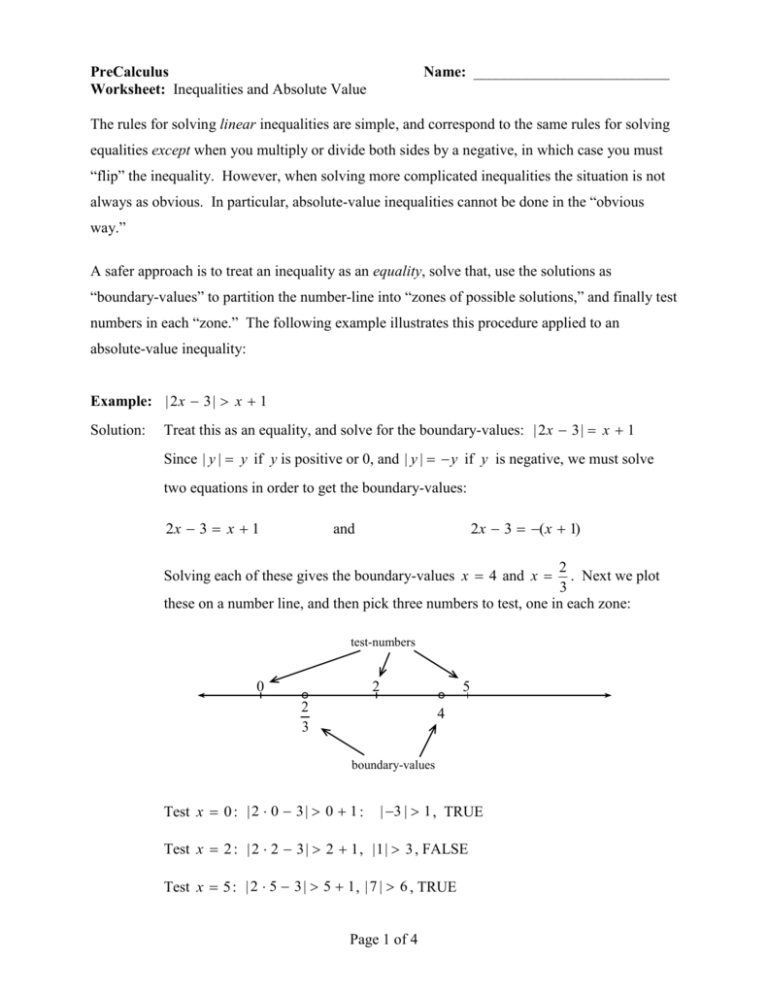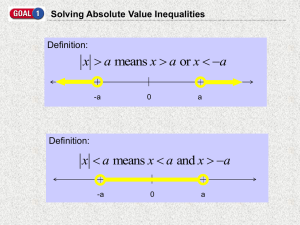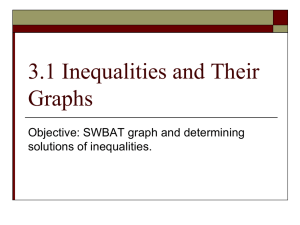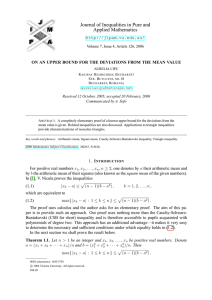Worksheet: Inequalities and Absolute Value
advertisement

PreCalculus Worksheet: Inequalities and Absolute Value Name: __________________________ The rules for solving linear inequalities are simple, and correspond to the same rules for solving equalities except when you multiply or divide both sides by a negative, in which case you must “flip” the inequality. However, when solving more complicated inequalities the situation is not always as obvious. In particular, absolute-value inequalities cannot be done in the “obvious way.” A safer approach is to treat an inequality as an equality, solve that, use the solutions as “boundary-values” to partition the number-line into “zones of possible solutions,” and finally test numbers in each “zone.” The following example illustrates this procedure applied to an absolute-value inequality: Example: | 2 x 3 | x 1 Solution: Treat this as an equality, and solve for the boundary-values: | 2 x 3 | x 1 Since | y | y if y is positive or 0, and | y | y if y is negative, we must solve two equations in order to get the boundary-values: 2x 3 x 1 2x 3 ( x 1) and 2 . Next we plot 3 these on a number line, and then pick three numbers to test, one in each zone: Solving each of these gives the boundary-values x 4 and x test-numbers 0 2 5 2 3 4 boundary-values Test x 0 : | 2 0 3 | 0 1 : | 3 | 1 , TRUE Test x 2 : | 2 2 3 | 2 1 , | 1 | 3 , FALSE Test x 5 : | 2 5 3 | 5 1 , | 7 | 6 , TRUE Page 1 of 4 Therefore, the solution is: x 2 or x 4 3 Inequalities which contain algebraic fractions must be treated even more carefully. The boundary-values not only contain values of the unknown that make the equality true, but they may also contain values that make a fraction undefined (that is, its denominator is 0). Furthermore, if the inequality includes an equality (that is, “ ” or “ ”) then a boundary-value that causes a fraction to be undefined can not be included in the solution. Example: 3 x3 x2 2 Solution: One of the boundary-values is x 2 because this makes the fraction 0. Treating it as an equality, 3 x3 , we cross-multiply to get: x2 x 6 6 . To x2 2 solve this equation, we subtract 6 from both sides, then factor: x2 x 12 0 , ( x 3)( x 4) 0 . The solutions of this equation are x 3 and x 4 . These two boundary-values are also solutions of the original inequality since it includes an equality, but the boundary-value x 2 is not a solution since it makes a fraction undefined. We must now test numbers in 4 zones determined by these three boundary-values: test-numbers –5 0 –4 2.5 2 4 3 boundary-values 3 5 3 3 , 1 , TRUE 5 2 2 8 3 03 3 3 Test 0: , , FALSE 02 2 2 2 2 .5 3 3 Test 2.5: , 6 2.75 , TRUE 2 .5 2 2 3 43 3 7 Test 4: , , FALSE 42 2 2 2 Test –5: Therefore, the solution is: x 4 or 2 x 3 . Page 2 of 4 Exercises: Solve. Show all work, including test-values. 1. |x 2| 3 2. | x 3| 2 3. | 3 2x | 5 4. | 2 x 1 | 3 5. | 3x 2 | x 2 6. |x| x 7. |3 x | x 3 8. |x 2| x 2 9. 2x | x 2 | 10. | x 5| x 5 Page 3 of 4 11. 1 1 x 5 12. 1 1 x 5 13. 2 1 x3 x2 14. 4 x5 x2 2 15. x 2 2 x3 16. 3 x5 x 2 Page 4 of 4











